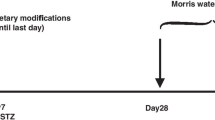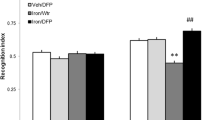Abstract
Metabolic dysfunction is a critical step in the etiopathogenesis of Alzheimer’s disease. In this progressive neurological disorder, impaired zinc homeostasis has a key role that needs to be clarified. The aim of this study was to investigate the effect of zinc deficiency and administration on hippocampal Nogo-A receptor and osteocalcin gene expression in rats injected with intracerebroventricular streptozotocin (icv-STZ). Forty male Wistar rats were divided into 5 groups in equal numbers: Sham 1 group received icv artificial cerebrospinal fluid (aCSF); Sham 2 group received icv a CSF and i.p. saline; STZ group received 3 mg/kg icv STZ; STZ-Zn-deficient group received 3 mg/kg icv STZ and fed a zinc-deprived diet; STZ-Zn-supplemented group received 3 mg/kg icv STZ and i.p. zinc sulfate (5 mg/kg/day). Hippocampus tissue samples were taken following the cervical dislocation of the animals under general anesthesia. Nogo-A receptor and osteocalcin gene expression levels were determined by real-time-PCR method. Zinc supplementation attenuated the increase in hippocampal Nogo-A receptor gene expression, which was significantly increased in zinc deficiency. Again, zinc supplementation upregulated the intrinsic protective mechanisms of the brain by activating osteocalcin-expressing cells in the brain. The results of the study show that zinc has critical effects on Nogo-A receptor gene expression and hippocampal osteocalcin gene expression levels in the memory-sensitive rat hippocampus that is impaired by icv-STZ injection. These results are the first to examine the effect of zinc deficiency and supplementation on hippocampal Nogo-A receptor and osteocalcin gene expression in icv-STZ injection in rats.


Similar content being viewed by others
Data Availability
The datasets generated during and/or analyzed during the current study are available from the corresponding author on reasonable request.
References
Xu YQ, Sun ZQ, Wang YT, Xiao F, Chen MW (2015) Function of Nogo-A/Nogo-A receptor in Alzheimer’s disease. CNS Neurosci Ther 21:479–485
Schwab ME (2010) Functions of Nogo proteins and their receptors in the nervous system. Nat Rev Neurosci 11:799–811
Pavon MV, Navakkode S, Wong LW, Sajikumar S (2022) Inhibition of Nogo-A rescues synaptic plasticity and associativity in APP/PS1 animal model of Alzheimer’s disease.Semin Cell Dev Biol S1084–9521(22)00130–6.
Wang J, Qin X, Sun H, He M, Lv Q, Gao C, He X, Liao H (2021) Nogo receptor impairs the clearance of fibril amyloid-β by microglia and accelerates Alzheimer’s-like disease progression. Aging Cell 20:e13515
Guo MF, Zhang HY, Zhang PJ, Liu XQ, Song LJ, Wei WY, Wang YY, Mu BT, Chai Z, Yu JZ, Ma CG (2020) Fasudil reduces β-amyloid levels and neuronal apoptosis in APP/PS1 transgenic mice via inhibition of the Nogo-A/NgR/RhoA signaling axis. J Integr Neurosci 19:651–662
Jiang R, Wu XF, Wang B, Guan RX, Lv LM, Li AP, Lei L, Ma Y, Li N, Li QF, Ma QH, Zhao J, Li S (2020) Reduction of NgR in perforant path decreases amyloid-β peptide production and ameliorates synaptic and cognitive deficits in APP/PS1 mice. Alzheimers Res Ther 12:47
Schatz M, Saravanan S, d’Adesky ND, Bramlett H, Perez-Pinzon MA, Raval AP (2020) Osteocalcin, ovarian senescence, and brain health. Front Neuroendocrinol 59:100861
Karsenty G (2017) Update on The Biology of Osteocalcin. Endocr Pract 23:1270–1274
Kosmidis S, Polyzos A, Harvey L, Youssef M, Denny CA, Dranovsky A (2018) Kandel ER (2018) RbAp48 protein is a critical component of GPR158/OCN signaling and ameliorates age-related memory loss. Cell Rep 25(4):959–973
Oury F, Khrimian L, Denny CA, Gardin A, Chamouni A, Goeden N, Huang YY, Lee H, Srinivas P, Gao XB, Suyama S, Langer T, Mann JJ, Horvath TL, Bonnin A, Karsenty G (2013) Maternal and offspring pools of osteocalcin influence brain development and functions. Cell 155:228–241
Sun D, Milibari L, Pan JX, Ren X, Yao LL, Zhao Y, Shen C, Chen WB, Tang FL, Lee D, Zhang JS, Mei L, Xiong WC (2021) Critical roles of embryonic born dorsal dentate granule neurons for activity-dependent increases in BDNF, adult hippocampal neurogenesis, and antianxiety-like behaviors. Biol Psychiatry 89:600–614
Tang W, Liu H, Ooi TC, Rajab NF, Cao H, Sharif R (2022) Zinc carnosine: Frontiers advances of supplement for cancer therapy. Biomed Pharmacother 151:113157
Abu-Elfotuh K, Hussein FH, Abbas AN, Al-Rekabi MD, Barghash SS, Zaghlool SS, El-Emam SZ (2022) Melatonin and zinc supplements with physical and mental activities subside neurodegeneration and hepatorenal injury induced by aluminum chloride in rats: inclusion of GSK-3β-Wnt/β-catenin signaling pathway. Neurotoxicology 91:69–83
Kim JW, Byun MS, Yi D, Lee JH, Kim MJ, Jung G, Lee JY, Kang KM, Sohn CH, Lee YS, Kim YK, Lee DY (2021) Serum zinc levels and in vivo beta-amyloid deposition in the human brain. Alzheimers Res Ther 13:190
Baltaci SB, Unal O, Gulbahce-Mutlu E, Gumus H, Pehlivanoglu S, Yardimci A, Mogulkoc R, Baltaci AK (2021) The role of zinc status on spatial memory, hippocampal synaptic plasticity, and insulin signaling in icv-STZ-induced sporadic Alzheimer’s-like disease in rats. Biol Trace Elem Res. https://doi.org/10.1007/s12011-021-02999-2
Livak KJ, Schmittgen TD (2001) Analysis of relative gene expression data using real-time quantitative PCR and the 2(-Delta Delta C(T)) Method. Methods 25:402–408
Gil V, Nicolas O, Mingorance A, Ureña JM, Tang BL, Hirata T, Sáez-Valero J, Ferrer I, Soriano E, del Río JA (2006) Nogo-A expression in the human hippocampus in normal aging and in Alzheimer disease. J Neuropathol Exp Neurol 65(5):433–444
Lu B, Zhang T, Yang F (2021) “Bone” in the Brain? Osteocalcin-expressing neurons in adult hippocampus promote neurogenesis and suppress anxiety. Biol Psychiatry 89:539–540
Acknowledgements
We thank Dr. Serhan Ozyıldırım for the English revision.
Funding
This study was supported by the Scientific Research Projects Coordinatorship of Selcuk University (SUBAPK; project no. 19102046).
Author information
Authors and Affiliations
Contributions
HG, SBB, OU, and EGM made substantial contributions to the conception or design of the work; or the acquisition, analysis, or interpretation of data; or the creation of new software used in the work. HG, SBB, RM, and AKB drafted the work or revised it critically for important intellectual content and approved the version to be published.
Corresponding author
Ethics declarations
Ethics Approval
The study protocol was approved by the Experimental Animals Ethics Committee of Selcuk University Experimental Medicine Research and Application Center (2019–44).
Conflict of Interest
The authors declare no competing interests.
Additional information
Publisher's Note
Springer Nature remains neutral with regard to jurisdictional claims in published maps and institutional affiliations.
Rights and permissions
Springer Nature or its licensor holds exclusive rights to this article under a publishing agreement with the author(s) or other rightsholder(s); author self-archiving of the accepted manuscript version of this article is solely governed by the terms of such publishing agreement and applicable law.
About this article
Cite this article
Gumus, H., Baltaci, S.B., Unal, O. et al. Zinc Ameliorates Nogo-A Receptor and Osteocalcin Gene Expression in Memory-Sensitive Rat Hippocampus Impaired by Intracerebroventricular Injection of Streptozotocin. Biol Trace Elem Res 201, 3381–3386 (2023). https://doi.org/10.1007/s12011-022-03410-4
Received:
Accepted:
Published:
Issue Date:
DOI: https://doi.org/10.1007/s12011-022-03410-4




